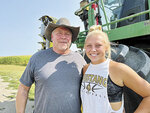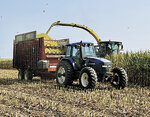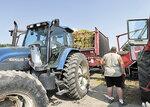Dave Stelter
Wood Lake, Minnesota
300 cows
Describe your farm and facilities. We have a freestall barn that we bed with sand. Our cows are milked in a double-6 parallel parlor. We farm about 750 acres.
What forages do you harvest? We harvest alfalfa, corn, rye and forage sorghum. We double crop oats, triticale or rye after our wheat is harvested. I sometimes interseed sorghum sudangrass into alfalfa that’s going out of production. We plant cover crops and harvest them as hay that we will feed to our heifers.
How many acres of crops do you raise? We have 400 acres of corn, 200 acres of alfalfa and 150 acres of rye or wheat. With a little luck and a little rain, we will use double cropping to harvest three crops every two years from every acre. We have also been transitioning a couple of farms over to organic crop production.
Describe the rations for your livestock. Our milking herd is fed a total mixed ration of corn silage, earlage, haylage, distillers grains and amino acids. Our youngstock is fed corn silage, grass hay, millet hay and straw. Cover crops make good feed for our youngstock. None of our heifers get a TMR until they are 11-12 months old. We feel this helps with rumen development.
What quality and quantity do you harvest of each crop? We harvest about 7,000 tons of corn silage, 1,000 tons of earlage and about 1,500 tons of haylage. We usually make more than 600 tons of sorghum silage and 500-600 tons of cover crop silage. We bale a lot of our alfalfa as dry hay and chop the rest.
Describe your harvesting techniques for alfalfa and corn silage. We bought a hay tedder and have found that tedding helps our hay dry faster. We have a large square baler that we use to make hay. I recently purchased a used self-propelled mower, and that has done a lot to help speed up hay harvest.
What techniques do you use to store, manage and feed your forages? We store our earlage in the Harvestore silo and bag the rest of our chopped forages. We store our big square bales in our hay shed and keep the big round bales of cover crops outside. Jason Prins, our nutritionist, and Jacob Bierstedt, from Chandler Feed Co., help us stay on top of things by sampling our forages often, especially when we open a new bag. The guy who feeds our cattle with our twin-screw vertical mixer wagon does a great job. He has been with us for 26 years.
How do quality forages play into the production goals of your herd? Harvesting top quality forages is my No. 1 goal. I have my own chopper, so I can chop when the crop is at its peak condition. Our rolling herd average has been holding mostly steady, but our milk components are very high and continue to go up. Quality forages are key to maintaining good milk production. Our pregnancy rate is over 30%, and we try to stay close to 160 days in milk.
What management or harvesting techniques have you changed that have made a notable difference in forage quality? It seems like the windows of harvesting time are getting smaller, but our equipment can go over more acres faster. We focus on the digestibility of our feedstuffs and plant high starch brown midrib corn hybrids for silage.
Describe a challenge you overcame in reaching your forage quality goals. When we fill a bag with haylage, we have found that it’s best to take small bites than large bites. Our goal is to chop 40-60 acres of alfalfa per day, which is about what we can accomplish in three hours. It’s a challenge to merge the windrows at just the right moisture. When we bag corn silage, we shoot for 65% moisture. We can fill three bags per day with corn silage, which works out to about 1,000 tons.



Comments
No comments on this item Please log in to comment by clicking here